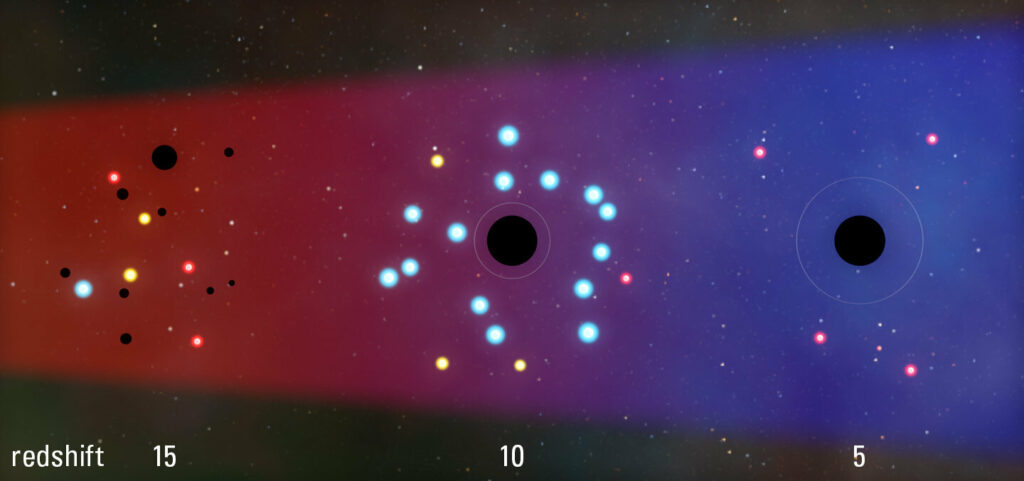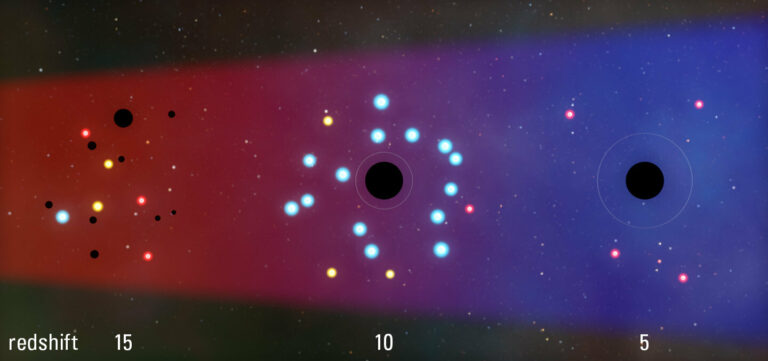Fresh Discoveries from JWST: The Transition of Black Holes from Star Formation Catalysts to Suppressors
The James Webb Space Telescope (JWST) has provided astronomers with a significant breakthrough in their quest to comprehend the early universe. By utilizing its infrared detecting capabilities, the telescope has detected a collection of small, red dots that are believed to be some of the earliest galaxies ever formed.
This remarkable revelation not only captivates the eye but also holds the potential to unravel the mysteries surrounding the origins of galaxies and their enigmatic black holes.
According to Mitch Begelman, an astrophysics professor at the University of Colorado Boulder and a JILA Fellow, the James Webb’s astonishing discovery reveals the existence of compact and infrared bright objects in the universe, which are likely regions where massive black holes already exist. This defies previous assumptions that such phenomena were impossible.
Begelman, along with a team of astronomers including Joe Silk, a professor of astronomy at Johns Hopkins University, has published their findings in The Astrophysical Journal Letters. Their research suggests that new theories of galactic formation are necessary to explain the presence of these colossal black holes.
Silk, the lead author of this potentially groundbreaking study, emphasizes the need for fresh perspectives to reconcile the existing theory of galaxy formation with the compelling new data.

The traditional tale of galaxy formation
Astronomers had previously proposed a relatively organized progression in their understanding of how galaxies came into existence. Traditional theories suggested that galaxies formed gradually, taking billions of years to assemble. According to this gradual cosmic evolution, stars were believed to be the first to emerge, illuminating the ancient darkness.
“The concept was that you transitioned from an initial generation of stars to galaxies being primarily composed of stars,” Begelman adds. “Then, towards the end of this process, you would begin to form these black holes.”
Supermassive black holes, those mysterious and influential entities, were thought to arise after the initial stars, quietly growing in the center of the galaxy. They were viewed as regulators, occasionally becoming active to control the formation of new stars and maintain a balance within the galaxy.
Challenging conventional wisdom
Thanks to the observations made by the JWST, it was discovered that the first galaxies in the universe were brighter than anticipated. These galaxies exhibited stars coexisting with central black holes called quasars.
Quasars are the most luminous objects in the universe, generated by gas accretion onto massive black holes in the nuclei of galaxies. They possess immense luminosities, overshadowing their host galaxies. They can be likened to monsters in the cuckoo’s nest, as described by Silk.
Upon witnessing the coexistence of stars and black holes, researchers quickly realized that the conventional theories of galaxy formation were flawed. The new data suggests a reversal in the process, indicating that these black holes formed alongside the first stars, with the rest of the galaxy following suit. According to Begelman, the growth of the black hole initially promotes the formation of stars, and only later, when conditions change, does it transition into a mode that suppresses star formation.
Through this newly proposed process, researchers discovered a closer relationship between star formation and black hole formation than expected. Initially, each amplifies the growth of the other through positive feedback, a violent interplay of birth and death that serves as the new beacon of galaxy formation, as stated by Silk.
After nearly a billion years, these nurturing giants turned suppressive, depleting the gas reservoirs in their galaxies and halting star formation. This negative feedback was a result of energy-conserving outflows, powerful winds that expelled gas from the galaxies, depriving them of the necessary material for creating new stars.
A new galactic timeline
The researchers have put forth a new timeline for the transition from positive to negative feedback in the formation of early galaxies, thanks to their discovery of the nurturing behavior of black holes. By analyzing the light spectra and chemical signatures emitted by these “little red dots,” they have determined that this shift took place approximately 13 billion years ago, one billion years after the Big Bang, which astronomers refer to as “z ≈6.”
This identification of the transition epoch is crucial for astronomers as it allows them to focus their observations on specific periods in the history of the universe. It will enable them to devise more effective observational strategies using telescopes like JWST and others to study the early universe in greater detail. Furthermore, understanding when this shift occurred will provide astronomers with a better understanding of the characteristics of modern galaxies, such as their size, shape, star composition, and activity level.
Validating a novel process
In order to verify the validity of this novel theory regarding the collaborative formation of galaxies involving stars and black holes, as well as gain deeper understanding of the underlying processes, computer simulations are required.
According to Begelman, this will be a time-consuming task. He explains that the current computer simulations are rather rudimentary and lack the necessary level of detail to fully comprehend the phenomenon. Achieving a comprehensive understanding requires significant computational power, which comes at a high cost.
However, until these simulations can be conducted, there are alternative measures that the astronomy community can undertake to evaluate and confirm this new theory.
Silk suggests that the next steps should focus on enhancing observations. He emphasizes the potential of the James Webb Space Telescope (JWST) to examine the spectra of the most remote galaxies in the coming years, which will greatly contribute to the validation process.
Both Begelman and Silk express optimism regarding the acceptance of their proposed idea within the field. Begelman acknowledges that their approach is quite unconventional, stating that they are likely the first to venture in such an extreme direction. He admits that over the years, he and his collaborators have been pushing the boundaries in their exploration of the black hole formation problem. However, the capabilities of the JWST have revealed that they need to think even more creatively and expand their perspectives.
This article is republished from PhysORG under a Creative Commons license. Read the original article.
Do not forget to share your opinion with us to provide you with the best posts !




0 Comments